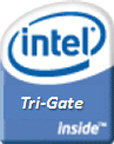Tri-Gate: The New Intel-Inside Part 2
By Tony Clark, 2-Dooz Inc. – March 4, 2013 (Original Publication Date)
 Last week, I discussed how the new focus on Tri-Gate in Intel’s growing foundry business can be viewed as a tactical expansion of the Intel-Inside program. An obvious benefit is the addition of a transistor-level perspective, which could provide the company with an opportunity to move beyond the traditional set of personal computer (PC) microprocessors for which it is best known. In this article I assume a “what if” scenario in which Intel pursues an even broader strategy: Tri-Gate Inside Everything. Discussed are the possible ramifications of implementing this strategy on the entire semiconductor industry.
Last week, I discussed how the new focus on Tri-Gate in Intel’s growing foundry business can be viewed as a tactical expansion of the Intel-Inside program. An obvious benefit is the addition of a transistor-level perspective, which could provide the company with an opportunity to move beyond the traditional set of personal computer (PC) microprocessors for which it is best known. In this article I assume a “what if” scenario in which Intel pursues an even broader strategy: Tri-Gate Inside Everything. Discussed are the possible ramifications of implementing this strategy on the entire semiconductor industry.
A more broadly defined Tri-Gate Inside Everything strategy has the potential to cause even more disruption than the x86 PC architecture. Alternatively stated, Intel’s Tri-Gate technology may present another inflection point level opportunity. Tri-Gate has the potential to become the de facto industry standard transistor technology. Tri-Gate Inside Everything could power the majority of the intelligent semiconductor based computing devices on the planet. Tri-Gate could power airplanes, ATMs, automobiles, cameras, clouds, computers, data networking equipment, e-readers, ovens, refrigerators, robots, smart meters, smart phones, set-top boxes, tablets, televisions, utility grids, watches, et cetera. Following is my take on how the pursuit of this strategy by Intel could impact ARM, AMD, and TSMC.
ARM Holdings licenses its reduced instruction set computer (RISC) designs to semiconductor manufacturers. Theoretically, ARM processors could be manufactured using Intel’s Tri-Gate technology. And, if (big IF) Intel were to license Tri-Gate for use in ARM cores, the integration of Tri-Gate into smart phone, digital TVs, and set-top boxes could be greatly accelerated. Thus, collaboration might be beneficial to both Intel and ARM. See “Intel Puts ARM on Notice” for a more confrontational take on how Tri-Gate might play out vis-à-vis ARM.
Advanced Micro Devices (AMD) is a long time, traditional competitor to Intel. The competitive implications of Tri-gate vis-à-vis AMD are obvious, so I’ll speculate on a collaborative possibility. AMD could license Tri-Gate or could use a third party foundry service, which has licensed Tri-Gate, for its processor product line. The obvious benefit to AMD is that it would give the company much needed access to next generation transistor and manufacturing processes. From Intel’s perspective, it would signal to the industry just how committed it is to making Tri-Gate available to all.
There is also a possible collaborative scenario for Taiwan Semiconductor Manufacturing Company (TSMC), the leading semiconductor foundry services player. If TSMC were to license Tri-Gate, it would accelerate the availability of their next generation process—essentially de-risking the challenges they are having with their internally developed 16 nm FinFET technology. For Intel, a collaborative relationship with TSMC could further accelerate the Tri-Gate adoption rate.
To be perfectly honest it would prove difficult for Intel to pursue the more comprehensive Tri-Gate Inside Everything strategy sketched above. Among other risks and challenges, the impact on their mature processor and system on chip businesses and the impact on their growing foundry business would have to be fully rationalized. At a minimum, Tri-Gate licensing revenue would have to exceed the loss in revenue in Intel’s traditional processor business. By the way, this is possible given the much larger base of devices that could be targeted by Tri-Gate. Intel could, with the proper execution, trigger and ride the Tri-Gate inflection point for many, many years to come.
Those are my thoughts. And, as always, I invite and look forward to learning what you think.
